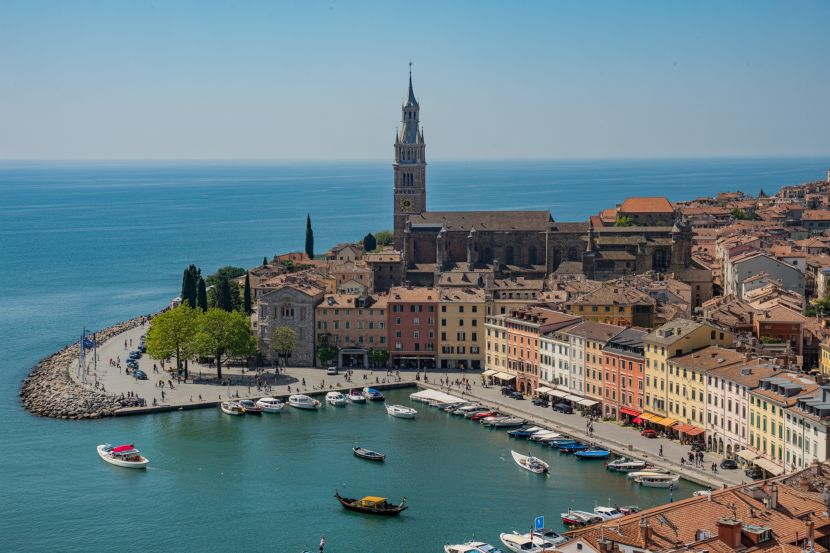Sustainable Tourism in Major European Cities: How Venice, Barcelona, and Lisbon Are Preparing for 2050 Challenges – Here’s What You Need to Know – Travel And Tour World

Report on Sustainable Tourism Strategies in Major European Cities in Alignment with UN Sustainable Development Goals
1.0 Introduction: Addressing Overtourism by 2050
Major European urban destinations, including Venice, Barcelona, and Lisbon, are developing long-term strategies to transition towards a sustainable tourism model by 2050. Faced with significant challenges from tourism overcrowding, these cities are implementing plans to mitigate negative impacts on local infrastructure, communities, and environments. This strategic shift is in direct alignment with the United Nations Sustainable Development Goals (SDGs), particularly those focused on sustainable cities, economic growth, and responsible consumption.
2.0 The Impact of Mass Tourism on Urban Sustainability
The continuous growth in tourism, with a 4% surge reported in the first half of 2025, has placed immense pressure on iconic European cities. These pressures directly challenge the achievement of several key SDGs.
2.1 Socio-Economic Disruptions and SDG 11
The consequences of unchecked tourism growth are undermining progress towards SDG 11 (Sustainable Cities and Communities).
- Housing and Infrastructure: Inflated living costs and rising rents are displacing local residents, straining public services and housing markets.
- Cultural Heritage: The over-commercialization of city centers threatens local culture and heritage, creating “monocultural” tourist zones and conflicting with SDG Target 11.4, which aims to protect cultural heritage.
2.2 Economic and Environmental Challenges
The economic benefits of tourism are often offset by significant environmental and social costs, impacting other development goals.
- Economic Viability (SDG 8): While tourism is a major economic driver, the current model often prioritizes tourist demands over local businesses, hindering the promotion of local culture and products as envisioned in SDG 8 (Decent Work and Economic Growth), Target 8.9.
- Environmental Degradation (SDG 12 & SDG 13): Increased pollution and waste generation from high tourist volumes contravene the principles of SDG 12 (Responsible Consumption and Production) and SDG 13 (Climate Action).
3.0 Strategic Frameworks for Sustainable Tourism Management
In response to these challenges, cities and governing bodies are formulating strategies that prioritize sustainability and responsible management, reflecting a commitment to the 2030 Agenda for Sustainable Development.
3.1 A Shift Towards Targeted, High-Value Tourism
A consensus is emerging, notably from discussions at the Global Tourism Forum, to move away from a model based on volume. The new approach focuses on attracting specific types of visitors whose interests align with the city’s unique cultural and environmental assets. This strategy supports SDG 12 by encouraging more responsible forms of travel and consumption.
3.2 Integration with Urban Development Planning
Sustainable tourism is being integrated into comprehensive urban strategies that encompass:
- Transportation
- Housing
- Local Business Development
This holistic approach ensures that tourism development supports, rather than undermines, the quality of life for residents and contributes positively to SDG 11.
3.3 The European Commission’s Policy Intervention
The European Commission is developing a sustainable tourism strategy, anticipated by 2026, to provide a cohesive framework for member states. This initiative aims to:
- Manage tourism congestion.
- Promote eco-friendly travel options.
- Enhance cross-border tourism.
This policy framework emphasizes the importance of SDG 17 (Partnerships for the Goals), recognizing that success depends on collaboration between public and private sectors.
4.0 Stakeholder Contributions to Sustainable Tourism
The transition to a sustainable model requires a multi-stakeholder approach, with a significant role for travelers in promoting responsible practices.
4.1 Recommendations for Responsible Travelers
Tourists can directly contribute to achieving the SDGs by adopting the following behaviors:
- Support Local Economies (SDG 8): Choose locally-owned accommodations and businesses over international chains.
- Protect Cultural Heritage (SDG 11): Respect local customs and traditions to prevent cultural erosion.
- Reduce Urban Strain (SDG 11): Travel during off-peak seasons to alleviate pressure on infrastructure.
- Minimize Environmental Impact (SDG 13): Utilize public transportation to reduce carbon emissions.
5.0 Conclusion: A Balanced Future for European Tourism
The future of tourism in Europe’s leading cities depends on the successful implementation of a balanced and sustainable model. By aligning tourism strategies with the Sustainable Development Goals, cities like Venice, Barcelona, and Lisbon can ensure they remain vibrant communities for residents while continuing to be world-class destinations. This requires sustained cooperation between governments, the private sector, and tourists to preserve the economic, social, and environmental well-being of these urban centers for 2050 and beyond.
Analysis of Sustainable Development Goals in the Article
1. Which SDGs are addressed or connected to the issues highlighted in the article?
-
SDG 8: Decent Work and Economic Growth
The article discusses tourism as a “major economic driver” but emphasizes the need for a sustainable model that creates “local business growth” and benefits residents. This directly connects to promoting sustained, inclusive, and sustainable economic growth.
-
SDG 11: Sustainable Cities and Communities
This is a central theme. The article focuses on the challenges faced by cities like Venice, Barcelona, and Lisbon due to “tourism overcrowding,” which strains “infrastructure,” “public services,” and “housing markets.” The goal is to make these urban centers inclusive, safe, resilient, and sustainable for local communities.
-
SDG 12: Responsible Consumption and Production
The article calls for a shift from “mass tourism” to “responsible tourism.” It highlights the need for “eco-friendly travel options” and encourages “responsible travel behavior” from tourists to ensure sustainable consumption and production patterns within the tourism industry.
-
SDG 17: Partnerships for the Goals
The article explicitly states that achieving a sustainable tourism model will require “cooperation between local governments, the private sector, and tourists.” It also mentions that “public-private partnerships will be crucial” for the success of the European Commission’s strategy, highlighting the importance of partnerships to achieve the goals.
2. What specific targets under those SDGs can be identified based on the article’s content?
-
Target 8.9: “By 2030, devise and implement policies to promote sustainable tourism that creates jobs and promotes local culture and products.”
The article directly addresses this by describing how cities are developing “long-term plans” and “strategies for sustainable tourism.” The focus on supporting “local businesses” and preventing the erosion of “local flavors and customs” aligns perfectly with promoting local culture and products.
-
Target 11.4: “Strengthen efforts to protect and safeguard the world’s cultural and natural heritage.”
The article expresses concern that mass tourism is “damaging local cultures” and leading to the “over-commercialization of cultural hubs.” The push for sustainable tourism is framed as an effort to protect the unique cultural fabric of these cities for both residents and future visitors.
-
Target 11.6: “By 2030, reduce the adverse per capita environmental impact of cities, including by paying special attention to air quality and municipal and other waste management.”
The article mentions the “environmental consequences of increased pollution and waste generated by tourism” as a key challenge. The promotion of “eco-friendly travel options” and the use of “public transport” are strategies aimed at mitigating these adverse environmental impacts.
-
Target 12.b: “Develop and implement tools to monitor sustainable development impacts for sustainable tourism…”
The entire discussion around developing a “sustainable tourism strategy” by the European Commission and the need for cities to create “urban strategies” that integrate tourism is an effort to implement tools and policies to manage and monitor the impacts of tourism.
-
Target 17.17: “Encourage and promote effective public, public-private and civil society partnerships…”
The article underscores the necessity of this target by stating that “public-private partnerships will be crucial to the success of this transition” and that the future of tourism “depends on the ability of cities to find a balanced approach” through “cooperation between local governments, the private sector, and tourists.”
3. Are there any indicators mentioned or implied in the article that can be used to measure progress towards the identified targets?
- Tourism Numbers and Growth Rate: The article mentions that “Tourism numbers in Europe surged by 4% in the first half of 2025.” This is a direct indicator used to measure the pressure of tourism on cities. A goal of sustainable tourism would be to manage or limit this growth in overcrowded areas.
- Development of Sustainable Tourism Strategies: The article states that the “European Commission is working on a sustainable tourism strategy, expected to be finalized by 2026.” The existence and implementation of such strategies at national and local levels serve as a key indicator of progress towards Target 12.b.1 (“Number of sustainable tourism strategies or policies and implemented action plans with agreed monitoring and evaluation tools”).
- Strain on Local Infrastructure and Services: The article implies that the condition of “public services,” “housing markets,” and “transportation” can be used as indicators. Metrics such as rising rent costs, housing availability for locals, and public transport capacity versus usage would measure the negative impacts of overtourism.
- Environmental Impact Metrics: The mention of “increased pollution and waste generated by tourism” implies that indicators such as air quality levels, carbon emissions from tourist transportation (e.g., taxis vs. public transport), and the volume of waste generated in tourist hotspots could be used to measure progress towards environmental sustainability (Target 11.6).
- Formation of Partnerships: The article highlights that “public-private partnerships will be crucial.” The number and effectiveness of these partnerships between governments, local businesses, and community groups would be an indicator of progress towards Target 17.17.
4. Table of SDGs, Targets, and Indicators
| SDGs | Targets | Indicators (Mentioned or Implied in the Article) |
|---|---|---|
| SDG 8: Decent Work and Economic Growth | 8.9: Promote sustainable tourism that creates jobs and promotes local culture and products. | Support for local businesses and preservation of local culture and customs. |
| SDG 11: Sustainable Cities and Communities | 11.4: Strengthen efforts to protect and safeguard the world’s cultural and natural heritage.
11.6: Reduce the adverse per capita environmental impact of cities. |
Measures to prevent the over-commercialization of cultural hubs; management of tourism numbers.
Levels of pollution and waste generated by tourism; usage of public transport by tourists. |
| SDG 12: Responsible Consumption and Production | 12.b: Develop and implement tools to monitor sustainable development impacts for sustainable tourism. | The development and implementation of a formal “sustainable tourism strategy” by the European Commission and local city governments. |
| SDG 17: Partnerships for the Goals | 17.17: Encourage and promote effective public, public-private and civil society partnerships. | The formation of “public-private partnerships” and cooperation between governments, the private sector, and tourists. |
Source: travelandtourworld.com
What is Your Reaction?
 Like
0
Like
0
 Dislike
0
Dislike
0
 Love
0
Love
0
 Funny
0
Funny
0
 Angry
0
Angry
0
 Sad
0
Sad
0
 Wow
0
Wow
0
















































:focal(1500,1000)/https://media.globalcitizen.org/a6/9a/a69a4720-d8a1-4715-b596-18738d03c05c/rotary_polio_hero_image.jpg?#)







/countries/sri-lanka/photo-credit---dmc-sri-lanka.tmb-1200v.jpg?sfvrsn=dc298bcc_1#)


















